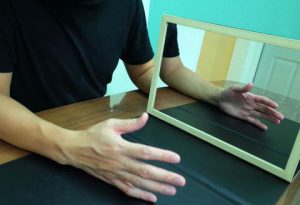The Mirror Therapy
Mirror Therapy, or mirror box therapy, is a physiotherapy/physical therapy and occupational therapy technique used to help increase movement and

decrease pain in limbs. It is suitable to treat conditions such as complex regional pain syndrome (CRPS), phantom limb pain, stroke and other chronic pain conditions. In many of these conditions the affected limb may not move well and it might be very painful when you try to move it. With adequate practice using mirror therapy, both patients and therapists have reported positive outcomes.
Background Of Mirror Therapy
Mirror therapy was first theorized by V. S. Ramachandran, Director of the Centre for Brain and Cognition, and Distinguished Professor with the Psychology Department and the Neurosciences Program at the University of California, San Diego. He is trained as a doctor and then obtained a Ph.D. from Trinity College at the University of Cambridge.
Ramachandran is credited with the invention of the mirror box and the introduction of mirror visual feedback as a treatment for phantom limb paralysis. This is known as mirror therapy.
V. S. Ramachandran has published over 180 papers in scientific journals and is referred to as “The Marco Polo of neuroscience” by Richard Dawkins and “The modern Paul Broca” by Eric Kandel.
To read more about the background and invention of mirror therapy, click here.
Mirror Therapy & The Brain
The brain is known to be “plastic”. The activity you perform daily, change the way the limb is represented in the brain. For example, if you are a pianist, both of your hands have a bigger representation in your brain. After any injury, the representation of the affected limb in the brain may be smaller or associated with pain.
Mirror therapy uses the brain’s prioritization of visual feedback over the sensation of the limb. In other words, mirror therapy involves using a mirror to “trick” the brain into thinking the affected limb is okay. During mirror therapy treatment exercises, the affected limb is covered and hidden behind a mirror. The movement of the good limb will thus be reflected in the mirror, allowing the brain to think that the affected limb is moving freely.
Evidence has shown that the areas of the brain are active during observation of the movement which are involved in the performance of movements. In simple terms, even though the brain can feel the affected limb is not moving, it forgets this and chooses to believe what it can see reflected in the mirror. With regular use of mirror therapy, the representation of the affected limb in the brain will change again. The brain will start to “learn” that this limb is okay and therefore will start to move it more easily.
How To Begin With Mirror Therapy Treatment & Exercises
Mirror therapy equipment can either be purchased and put together independently or can be bought online as a set. There are a variety of types of mirror boxes. However, as long as the main principles are followed, the shape and design of the box should not matter. The most important thing is that the affected limb is hidden and that the mirror is big enough to see all movements carried out with the opposite limb. The recommended size is a mirror of 25 x 20 inches for the upper limb, and at least 35 x 25 inches for the lower limb.
The choice of material for the mirror is also important. Perspex mirrors with smooth edges can be used to avoid injuries but it is important that the mirror does not buckle as this would distort the image. The “box” part of the mirror box should be made from a neutral color so that it does not draw attention away from the patient, and the mirror should be large enough to cover the whole of the affected limb. If making a mirror box is too difficult, you can purchase a ready-made mirror box therapy equipment from us here.
Find out more about the benefits and why you should use Mirror Therapy here.
< Return To Home | Mirror Therapy Box Rehab Kit >